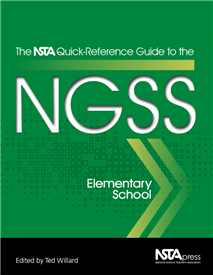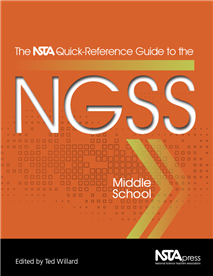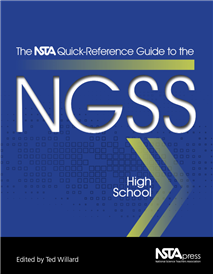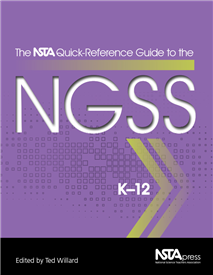All Book Chapters
Book Chapter
What Are Some Instructional Strategies That Support Conceptual Understanding?
In this chapter, strategies are described that can be used to promote learning within an instructional model. There are many strategies that researchers and practitioners have determined to be effective in supporting conceptual understanding. This ch...
Book Chapter
How Does Linking Assessment, Instruction, and Learning Support Conceptual Understanding?
This chapter focuses on connecting instruction, assessment, and learning. It features some of the ways you can use formative assessment to support conceptual understanding in science so that teachers can make better instructional decisions that suppo...
Book Chapter
What Role Does Informal Education Have in Developing Conceptual Understanding?
This chapter addresses learning in informal environments and in this age of technology, informal education is everywhere. Although opportunities have been available for many years, it’s only recently that educational researchers have become interes...
Book Chapter
Putting It All Together: “Balancing” Case Study
This Appendix features a case study of a lesson on “balancing” using the principles and ideas espoused in the book and in A Framework for K–12 Science Education. To illuminate the three dimensions and the four strands in “science as practic...
Book Chapter
Bond Character and Molecular Polarity
The purpose of this lab is to introduce students to the concepts of bonds and molecular polarity to determine ”How Does Atom Electronegativity Affect Bond Character and Molecular Polarity?” It also gives students an opportunity to use a computer ...
Book Chapter
The purpose of this lab is to introduce students to the valence shell electron pair repulsion (VSEPR) model and to determine ”How Does the Number of Substituents Around a Central Atom Affect the Shape of a Molecule?” It also gives students an opp...
Book Chapter
The purpose of this lab is to introduce students to the concepts of solutes, solvents, solubility, and rate of dissolution....
Book Chapter
The purpose of this lab is to introduce students to the concepts of solutes, solvents, and molarity. It gives students an opportunity to use a computer simulation to explore “What Is the Mathematical Relationship Between the Moles of a Solute, the ...
Book Chapter
Temperature Changes Due to Evaporation
The purpose of this lab is to introduce students to intermolecular forces. It gives students an opportunity to determine ”Which of the Available Substances Has the Strongest Intermolecular Forces? based on the temperature change observed during eva...
Book Chapter
Pressure, Temperature, and Volume of Gases
The purpose of this lab is to introduce students to the gas laws related to pressure, temperature, and volume of gases. It gives students an opportunity to develop a mathematical model that can be used to describe “How Does Changing the Volume or ...
Book Chapter
The purpose of this lab is to introduce students to periodic trends. It gives students an opportunity to explore the values of different properties for all elements in the periodic table to determine ”Which Properties of the Elements Follow a Perio...
Book Chapter
Solutes and the Freezing Point of Water
The purpose of this lab is to introduce students to colligative properties, which are the physical changes that result from adding solute to a solvent. During this investigation, students explore ”How Does the Addition of Different Types of Solutes...
Book Chapter
The purpose of this lab is for students to apply their understanding of intermolecular forces to explain observed differences in the melting point of four substances. It gives students an opportunity to develop a conceptual model that accounts for �...
Book Chapter
Identification of an Unknown Based on Physical Properties
The purpose of this lab is for students to apply what they have learned about physical properties and the nature of solutes, solvents, and solutions to identify ”What Type of Solution Is the Unknown Liquid?” The Teacher Notes provide the connecti...
Book Chapter
Atomic Structure and Electromagnetic Radiation
The purpose of this lab is for students to apply what they know about atomic structure to determine ”What Are the Identities of the Unknown Powders?” In this activity, students will learn about the importance of identifying patterns in science. T...
Book Chapter
Magnetism and Atomic Structure
The purpose of this lab is for students to apply what they have learned about atomic structure to explore ”What Relationships Exist Between the Electrons in a Substance and the Strength of Magnetic Attraction?” The Teacher Notes provide the conne...
Book Chapter
Density and the Periodic Table
The purpose of this lab is for students to apply what they know about physical properties and periodic trends to predict ”What Are the Densities of Germanium and Flerovium?” The Teacher Notes provide the connections to standards, a timeline, safe...
Book Chapter
The purpose of this lab is for students to apply what they know about the concepts of moles and molar mass to discover ”What Are the Identities of the Unknown Compounds?” The Teacher Notes provide the connections to standards, a timeline, safety ...
Book Chapter
The purpose of this lab is for students to apply their understanding of the ideal gas law to complete a design challenge ”How Can a Value of R for the Ideal Gas Law Be Accurately Determined Inside the Laboratory?” It also gives students an opport...
Book Chapter
Development of a Reaction Matrix
The purpose of this lab is to introduce students to the idea of chemical reactions and how they can be used to discover ”What Are the Identities of the Unknown Chemicals?” Completing a series of reactions will allow students to identify a set of ...
Book Chapter
The purpose of this lab is to introduce students to the concept of mole ratios, limiting reactants, and excess reactants and to discover ”Why Does Mixing Reactants in Different Mole Ratios Affect the Amount of the Product and the Amount of Each Rea...
Book Chapter
The purpose of this lab is to introduce students to the Brønsted-Lowry acid-base theory. It will help them to identify ”Why Do Strong and Weak Acids Behave in Different Manners Even Though They Have the Same Chemical Properties?” The Teacher Not...
Book Chapter
The purpose of this lab is to introduce students to the concepts of enthalpy, enthalpy change, and the difference between exothermic and endothermic processes. It also helps them discover “How Can Chemists Use the Properties of a Solute to Predict ...
Book Chapter
The purpose of this lab is to introduce students to the concept of a reaction rate and some of the factors that affect it to determine ”Why Do Changes in Temperature and Reactant Concentration Affect the Rate of a Reaction?” It also gives them a...
Book Chapter
The purpose of this lab is to introduce students to the concept of chemical equilibrium and some of the factors that affect the equilibrium point of a reaction. It will help students determine ”Why Do Changes in Temperature, Reactant Concentration,...
Book Chapter
Classification of Changes in Matter
The purpose of this lab is to allow students to apply their understanding of chemical and physical changes to different scenarios to determine ”Which Changes Are Examples of a Chemical Change, and Which Are Examples of a Physical Change?” The Tea...
Book Chapter
Identification of Reaction Products
The purpose of this lab is to give students an opportunity to apply their understanding of chemical reactions and solubility rules to determine ”What Are the Products of the Chemical Reactions?” The Teacher Notes provide the connections to standa...
Book Chapter
Acid-Base Titration and Neutralization Reactions
The purpose of this lab is for students to apply what they know about the characteristics of acids and bases, neutralization reactions, and stoichiometry to answer a practical question ”What Is the Concentration of Acetic Acid in Each Sample of Vi...
Book Chapter
Composition of Chemical Compounds
The purpose of this lab is to allow students to apply their understanding of the law of constant composition and the law of conservation of mass to determine ”What Is the Empirical Formula of Magnesium Oxide?” The Teacher Notes provide the connec...
Book Chapter
Stoichiometry and Chemical Reactions
The purpose of this lab is to allow students to apply their understanding of stoichiometry as it relates to the reactants and products of a chemical reaction to determine ”Which Balanced Chemical Equation Best Represents the Thermal Decomposition o...
Book Chapter
The purpose of this lab is to allow students to apply their understanding of endothermic and exothermic processes and engineering practices to design a new product. It gives them an opportunity to learn how to use findings from an investigation and a...
Book Chapter
The purpose of this lab is for students to apply what they know about reaction rates and how concentration affects a reaction to determine ”What Is the Rate Law for the Reaction Between Hydrochloric Acid and Sodium Thiosulfate?” The Teacher Notes...
Book Chapter
Equilibrium Constant and Temperature
The purpose of this lab is to give students an opportunity to apply what they know about chemical equilibrium to determine ”How Does a Change in Temperature Affect the Value of the Equilibrium Constant for an Exothermic Reaction?” The Teacher Not...
Book Chapter
Mrs. Carter's Butterfly Garden sample
In this free sample from Mrs. Carter's Butterfly Garden, young naturalists will gain information about a very special butterfly garden. Children can learn from Mrs. Carter’s example why it’s good for people when butterflies have welcoming spaces ...
Book Chapter
This free sample from My School Yard Garden will help children learn what insects, animals, and plants need to thrive—and how much fun it is to observe and record it all. My School Yard Garden is proof that you can learn a lot from a garden, no mat...
Book Chapter
K-12 Progressions, Elementary School
This free sample chapter shows the K–12 progression of each of the components in the foundation box (e.g., practices, core ideas, or connection to nature of science). These matrixes will help you understand what students are expected to know and d...
Book Chapter
The purpose of this free sample lab is to introduce students to the physical and chemical properties of acids and bases. The lab can be used at the beginning of a unit on acid-base chemistry to set the stage for future lessons and investigations. Thi...
Book Chapter
K-12 Progressions, Middle School
This free sample chapter shows the K–12 progression of each of the components in the foundation box (e.g., practices, core ideas, or connection to nature of science). These matrixes will help you understand what students are expected to know and d...
Book Chapter
K-12 Progressions, High School
This free sample chapter shows the K–12 progression of each of the components in the foundation box (e.g., practices, core ideas, or connection to nature of science). These matrixes will help you understand what students are expected to know and d...
Book Chapter
This free sample chapter shows the K–12 progression of each of the components in the foundation box (e.g., practices, core ideas, or connection to nature of science). These matrixes will help you understand what students are expected to know and d...










